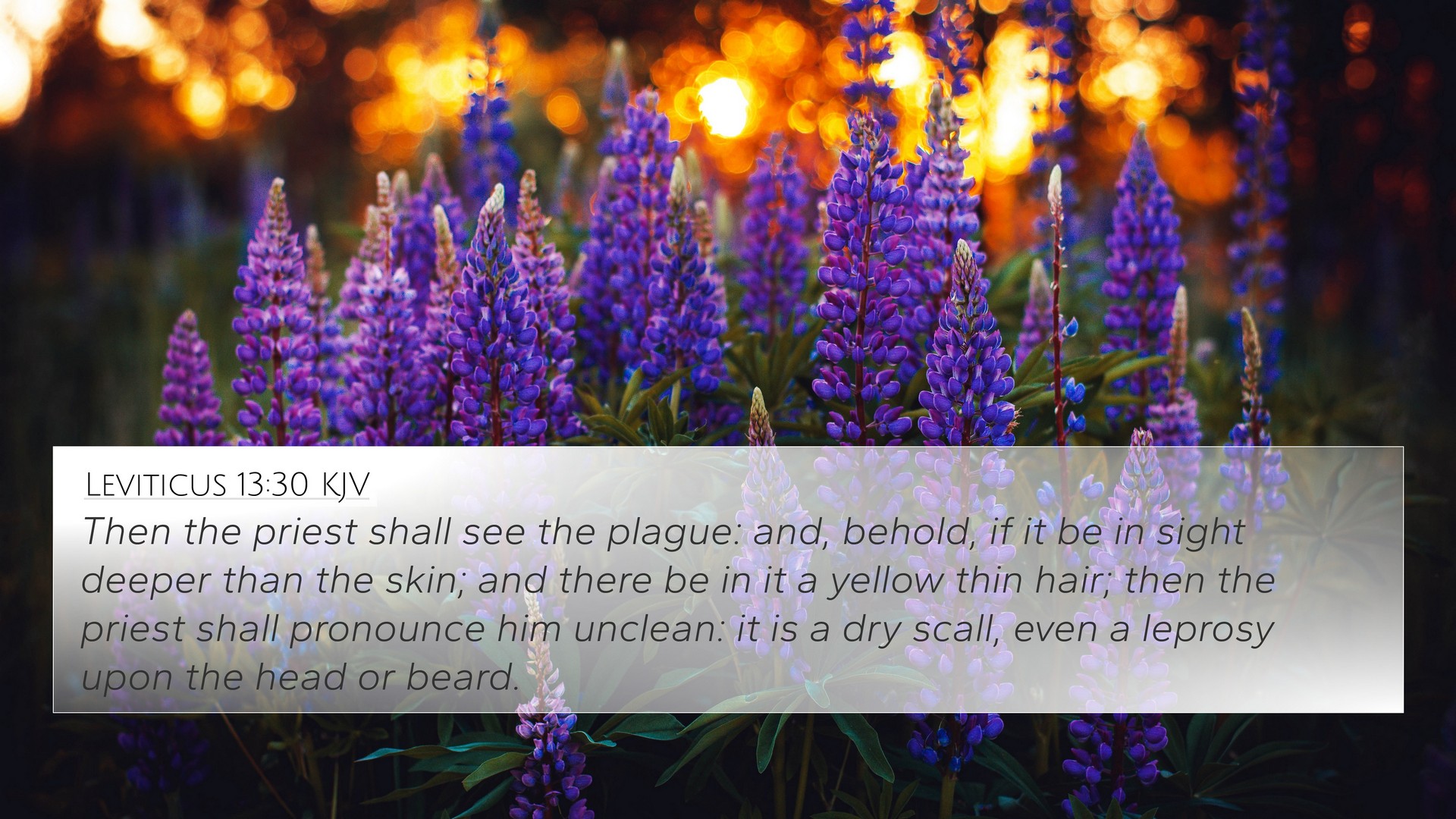Understanding Leviticus 13:30
The verse Leviticus 13:30 states, "Then the priest shall examine the sore on the man's head; and if it appears deeper than the skin, and the hair on it is turned white, the priest shall pronounce him unclean: it is a leprous sore." This verse is a part of the regulations concerning skin diseases, particularly leprosy, which was a significant concern in ancient Israel.
Summary of Insights from Commentaries
This section synthesizes insights from public domain commentaries such as those by Matthew Henry, Albert Barnes, and Adam Clarke.
Matthew Henry's Commentary
Matthew Henry emphasizes the role of the priest as an authority in identifying ceremonial cleanliness and uncleanliness. He notes that skin diseases were often seen as a sign of divine displeasure. The process of examination by the priest symbolizes the importance of spiritual and physical purity among God’s people.
Albert Barnes' Commentary
Albert Barnes highlights that leprosy in this context serves as a metaphor for sin, indicating that just as leprous conditions required careful observation and assessment, so does sin require examination and acknowledgment. He notes that the appearance of the sore and the white hair signify the seriousness of the condition, thus calling for a thorough evaluation by the priest.
Adam Clarke's Commentary
Adam Clarke provides insights into the significance of the white hair as an indication of the seriousness of the affliction. He discusses the health and communal implications of leprosy, suggesting that understanding such physical ailments is important for both personal well-being and communal health.
Key Themes and Reflections
- Purity and Cleanliness: The underlying theme of this verse revolves around the concept of physical and spiritual purity.
- The Role of the Priest: The priest acts as a mediator who not only carries out the examination but also communicates God’s will to the people.
- Sins and Sickness: The connection between physical ailments and spiritual conditions is a recurring theme in scripture.
- Community Health: The implications of leprosy extend beyond the individual to the health and purity of the entire community.
- Divine Judgment: Understanding ailments as potential signs of divine displeasure encourages an introspective approach to health and morality.
Bible Cross-References
Leviticus 13:30 connects with several other Bible verses, providing broader theological and contextual insights:
- Leviticus 14:1-32: The process of purification following leprosy, demonstrating God's provision for healing and restoration.
- Numbers 12:10-15: The case of Miriam, showcasing the consequences of speaking against God's chosen leader and the importance of communal cleanliness.
- Deuteronomy 24:8: Instructions on the examination of a person’s condition, emphasizing the spiritual significance of cleanliness.
- Matthew 8:2-4: Jesus healing a leper, affirming His authority over physical ailments and His compassion for the unclean.
- Mark 1:40-45: The story of the leper who came to Jesus, further illustrating the New Testament paradigm of cleansing and healing.
- Luke 5:12-16: Jesus’s interaction with leprosy reinforces the transformational power of faith and divine authority.
- 2 Corinthians 7:1: This verse reminds Christians to pursue holiness, reflecting the ongoing theme of spiritual cleanliness akin to the laws in Leviticus.
Thematic Connections
This verse illustrates many connections between the Old and New Testaments. Scripture often addresses themes of health, sin, and purification.
- Old Testament vs. New Testament: The ritualistic practices of the Old Testament lay a foundation for understanding New Testament principles of healing and grace.
- Sin and Affirmation of Value: The discourse around leprosy often serves as a backdrop to discussions on the inherent value of individuals despite their conditions, seen in Jesus's ministry.
- Physical and Spiritual Health: Leviticus highlights the intersection of physical health concerns with spiritual well-being, an important notion in Christian doctrine.
Tools for Bible Cross-Referencing
Utilizing tools for Bible cross-referencing is crucial for deeper study:
- Bible Concordance: An essential resource for finding specific topics, themes, and cross-references.
- Bible Cross-Reference Guide: Helps in discovering connections and themes throughout various books of the Bible.
- Cross-Reference Bible Study Methods: Techniques such as thematic studies or chain references help grasp the continuity and motifs across the scriptures.
- Comprehensive Bible Cross-Reference Materials: Various materials exist to aid in the exploration of inter-Biblical dialogue.
Conclusion
In examining Leviticus 13:30, one encounters a profound exploration of themes surrounding purity, authority, and the interconnectedness of physical and spiritual health. The insights from numerous commentaries, alongside cross-referenced scripture, enrich the understanding of this text. As believers seek to connect the dots within the Bible, engaging in comparative studies through cross-referencing will enhance the journey of faith and understanding.




